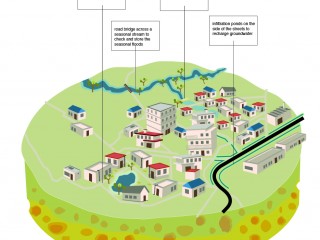Project Results:
The Sponge Town project Kitui aimed at demonstrating a new way of planning and work with water in urban centres in rural arid and semi-arid lands. The innovation lies in the concept which combines water buffering and recharges with the characteristics and opportunities of a built environment.
Sponge Cities make the best out of two extremes (flood and drought) with its buffering function. The Sponge holds water during rains – limiting flood hazards, and releasing it slowly when it is dry – increasing water availability. Protecting against floods and preventing a water deficit.
Sponge cities are an innovative and practical way for cities to keep up with the rising demand for water, and the need to protect people and assets. Sponge cities focus on sustainable and functional water management in an urban setting. It is a city that can ‘hold, clean and drain water in a natural way’. This is done by combining landscape-based and water buffering methods, engaging partners and communities to work together on making their city a nicer place to live. The key goals of a Sponge City are in line with policies for urban development to improve water quality, diversify water supply and flood protection.
VIA Water did support two parallel Sponge City projects in Kenya. Next to this project, a similar project was executed in Kajiado town by a consortium led by the RAIN Foundation. The difference between the two was the approach: the Kajiado sponge town started from a technical mapping, whereas this project started from a student design workshop.
The comparison resulted in guidelines for the development of similar Sponge City initiatives. In the Sponge City concept, public and private infrastructures like roads, drainage, buildings and sanitation are designed in such a way that they promote the infiltration of rainwater while limiting the negative impact of pollution and contamination of the underground water sources.
Key results
- Tested and validated Sponge Town approach
- Development of a guideline document for the development of similar Sponge City initiatives, which can be used as a key for scaling the concept
Tips for the future
- Work more closely with town and county administration and other stakeholders (platform etc.) towards concrete planning
- Be deliberate about selling the concept and vision to community, administration, politicians etc. Do not wait until it is finished, but sell the vision and the opportunity to part-take.
- Involve students more in implementation, also from secondary schools
- Work on sustainability aspects (e.g. maintenance school catchment system)
- Incorporate existing business ventures into the plan / solution (e.g. water vendors)
- Seek dynamic interactions between stakeholders and partners where problems are discussed and solved
Project partners
The consortium is formed by three partners with a well-mixed background and array of skills. The project partners include both Dutch and Kenyan organizations: South-East Kenya University (SEKU), SASOL Foundation and MetaMeta Research.
Period
November 2016 – November 2018
Location
Kwa Vonza, KenyaLast project updates
Background
ASALs occupy more than 80% of the country and are home to around 10 millions of people. Nevertheless, this conspicuous part of the country is consistently scoring low when it comes to development and economic growth. More than 60% of its inhabitants live in poverty. One of the main factors contributing to this is environmental degradation. Water is a key factor for the development of ASALs, which are recurrently hit by drought due to an unpredictable weather pattern and the growing effects of climate change and shocks. Nevertheless, long dry periods are commonly followed by destructive floods events, which not only pose a constant hazard to life and assets, but also make the water available in very short bursts. This is a recurrent pattern observed in both rural and urban areas of Kitui County. Water scarcity in the dry season and waterlogging and floods during the rainy season both pose different challenges, the recurrent question is how to turn these challenges into a positive asset. Booming towns in Kitui County – as well as in other ASALs counties - face an immediate need to develop additional/alternative resources for water provision and regulation.
Project Plan
1st Objective: Engage with a citizen platform where innovations and plans are discussed by a broad representations of society.
Kenyan society offers some strong examples of platforms where citizens can voice their ideas and challenges. Therefore, the project will preferably select existing platforms, thus avoiding the risk of working through artificial constructs that are unlikely to last beyond the project period. The platform will act as both decision platform and as validation instrument.
The technical planning of innovative ways of managing storm and rainwater necessarily needs a clear understanding of the hydrological situation as well as the existing water management practices and socio- economic conditions. Therefore, the second objective.
2nd Objective: Develop a clear understanding of water resources, hydrological situation and socio-economic setting by bringing together local knowhow with science based understanding of the urban settings.
Accordingly, the consortium will develop at first a clear baseline in the selected town by creating a technical task force. The taskforce will be composed by geologists, water resource experts, socio-economic experts from SEKU, SASOL, MetaMeta Research and possibly the concerning County offices. At the same time, the project will engage recently graduated students in mapping the water drainage of selected pilot areas. Gathering existing data and collecting first hand data will form the basis of the baseline. One important component of the study will address the existing practices for the management of storm water, but also the existing/potential water sources that might benefit from the wise management of storm water.
Both individual citizens, community and project based efforts will be therefore documented. The baseline will also be central in monitoring and evaluating the progress of the project. The baseline will be discussed and validated by the town platform before proceeding with the planning phase, which is the central point of the third objective.
3rd Objective: Develop storm water and runoff management plans for one town in Kitui County, which will define both a long term plan for the town and the details for the project pilot.
The technical taskforce will work together and supervise a number of technical teams of recent graduates from SEKU in making plans for four “Sponge Neighbourhoods”, which will be delineated as independent hydrological units with a common outlet. Each team will be in charge of mapping the present drainage patterns starting from paved areas, roads and roofs, down to the open drains that characterize the cities, to their present outlets.
To avoid the risk of contamination pollution hazard (e.g. waste and faecal sludge) will be also mapped thoroughly as a form of prevention when planning to recharge surface water in the aquifer. The hazard mapping might then indicate which are the danger areas to carefully avoid when changing the storm water patterns.
In a second phase the teams will engage in making plans for the creation of sponge neighbourhood plans. Once drafted the plans will be scrutinized and ranked against a set of criteria by a panel of experts. After validation they will be presented to the citizen platform and to the county governement which will cast its vote in selecting the plan to be used for the implementation of the pilot. The fourth objective is all about piloting the approved neighbourhood plan/s.
4th Objective: Pilot the neighbourhood plan/s by engaging local craftsmen, innovative citizens and institutions/organizations.
The envisioned measures will be broadly divided in two categories. A first set of measures will need external financial and knowledge support and will encompass bigger structures (e.g. Sand dams, Medium-sized ponds, major drainage lines). A second set of structures includes measures that can be taken up by single households (e.g. rooftop water harvesting, rain gardens). For the bigger structures skilled labour will be provided by local artisans with the technical support of SASOL. Management of bigger structures will be in the hand of the county, which will be trained in both technical, financial and human management of the structures.
On the other hand, also private household measures will be promoted. The most convenient and feasible way will be identified during the baseline/planning phase. One possibility is to initialize a small revolving fund or to provide materials at subsidized price without distorting the local market dynamics.
Not only recharge and retention are important aspects of the implementation plan. Reuse is the third part of the function that makes water available to the community thus closing the water loop. The applied measures will either make water directly available to the population through existing shallow wells, wells, galleries ponds or cisterns. Otherwise, a number reuse measures will be funded by the project. The adsorption and retention of water in the soil will be stimulated (using berms and swales) to favour the re-greening of the urban environment and the creation of small green islands – both in private compounds and in common areas.
The implementation of the pilot together with the baseline and planning phase are part of a novel process. It is therefore a major aim of the project to act as first example from which other cities and citizens can learn from. Accordingly, the fifth and final objective is:
5th Objective: Work on a consolidated Sponge Town guidelines for upscaling the Kitui experience and develop innovative communication packages to spread the lessons learnt at grassroots level, county and national level.
Throughout the length of the project, every step will be documented in order to build up the evidences to support the creation of sponge towns, what are the suggested measures in different situations and what are the engagement processes that are conducive to it. The guideline will be prepared with inputs from the sister project Sponge City Kajiado, in order to create one harmonized document that draws from the lessons learnt in the two pilots. The guidelines will be then jointly elaborated and presented at one event together with national and local authorities. Co-ownership of the guidelines and approach with authorities is the final aim.
The project inherently needs to reach grassroots citizens in order to foster their active involvement throughout the project. Accordingly, the project will sponsor the creation of a tune to be reproduced on local media as well as at local events. Likewise, a promotional video and graphical material (flyers, graphical instructions) will be produced.
Target group
Kwa Vonza inhabitants in all its shades and complexity. Women and Men, Youth and Elders, decision makers and the unheard, students and private business.
Sustainability
The proximity of Kwa Vonza university to the campus of SEKU will allow the project outcome and implemented measures to become a perfect research project for students specializing in soil and water management.
Financial sustainability measures - cost recovery, management funds etc - will be studied once the feasible technologies are selected.
Overview of Goals
The town of Kwa Vonza and its inhabitants experiment with Water buffering technologies and learn to include Sponge town measures in development and investment plans.
The sponge town approach is tested, validated and becomes an inspirational example for other towns of Kenyan Arid and Semi-Arid lands.
Results and indicators
- 1 - Continuous engagement with citizen platform
- Platform is engaged on a constant base 1 ( target )
- 2 - Baseline report
- Baseline study methodology produced 1 ( target )
- Baseline study produced and validated 1 ( target )
- 3 - Sponge city plans developed
- Number of plans developed and approved by citizen platform 1 ( target )
- 4 - Measures implemented according to plans;
- Typology of water buffering technologies implemented 5 ( target )
- Number of water buffering systems implemented 100+ ( target )
- 5 - Sponge town guidelines
- One sponge town guideline developed 1 ( target )


